Exercise as Intervention for Diabetes
The assignment is a critical review of literature on the topic of dying with dignity in hospital or in the community, focusing on end of life care that may not always reflect patient wishes.
37 Pages7723 Words312 Views
Added on 2023-04-21
About This Document
This literature review explores the effectiveness of exercise therapy as a non-pharmacological intervention for managing diabetes in a population of 18 to 60 years old. It discusses the benefits of exercise, challenges in adherence, and strategies to improve adherence. The review also includes a critical appraisal of eight research articles on the topic.
Exercise as Intervention for Diabetes
The assignment is a critical review of literature on the topic of dying with dignity in hospital or in the community, focusing on end of life care that may not always reflect patient wishes.
Added on 2023-04-21
ShareRelated Documents
Running head: EXERCISE AS INTERVENTION OF DIABETES
Exercise as intervention of diabetes
Name of the student:
Name of the university
Author note:
Exercise as intervention of diabetes
Name of the student:
Name of the university
Author note:
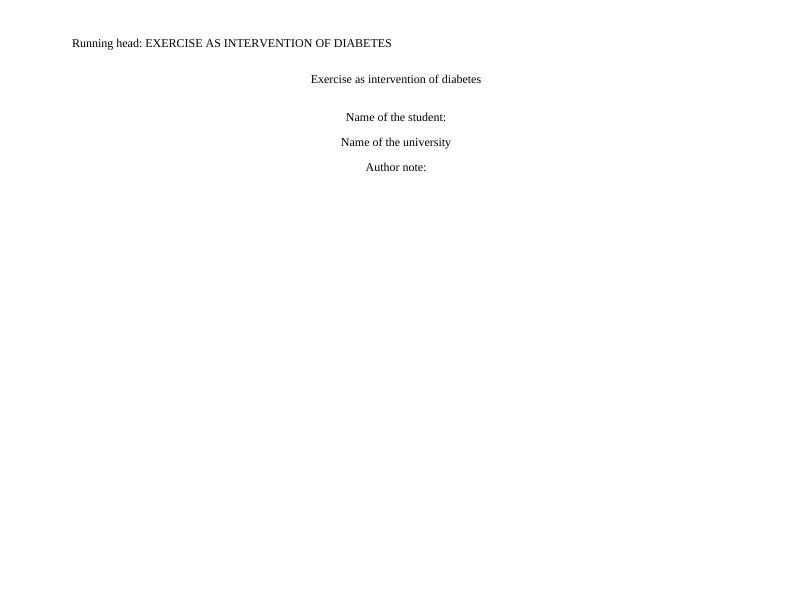
1
EXERCISE AS INTERVENTION OF DIABETES
Introduction:
With the growing prevalence of chronic disease, diabetes type II has become a public health concern that contributed to the
global burden of the disease and premature death. A study by Roze et al. (2016 ), suggested that in united kingdom approximately 24
millions of individuals are suffering from this chronic disease which affected their quality of life . A significant number of individuals
have above normal blood glucose level. Therefore, populations who are at higher risk of developing diabetes type II can also develop
other chronic diseases such as kidney and liver disease and cardiovascular. The issue is prevalent in the Asia Pacific region due to the
specific race and ethnicity but United Kingdom also identified one of the countries for higher prevalence (Patel et al. 2017). Ntuk et
al . (2014), suggested that a considerate number of individuals were refuse to seek clinical help due to high expenditure of the
pharmacological interventions. A study Scheen (2015), suggested that the implementation of physical activity as a component of
lifestyle interventions is useful for reducing the global burden of the disease. However, the lack of clinical applications of this
intervention and low patient adherence are huge barriers for improving patient outcome (Campbell et al. 2014). This paper will
illustrate a literature review of diabetes in the first part and critical appraisal of a paper in second part in the following paragraphs.
Background of the study:
According to Punthakee et al. (2017), approximately 24 million of the individuals in the United Kingdom are affected by this
chronic disease which increased their risk of premature death. A study by Shah et al. (2015), suggested that diabetes mellitus causes
production of insulin impaired. As discussed by Green et al. (2015), that because of this health condition, type II diabetes patient
experience physically weakness and therefore, physical activity is crucial for improving the blood glucose level in individuals.
EXERCISE AS INTERVENTION OF DIABETES
Introduction:
With the growing prevalence of chronic disease, diabetes type II has become a public health concern that contributed to the
global burden of the disease and premature death. A study by Roze et al. (2016 ), suggested that in united kingdom approximately 24
millions of individuals are suffering from this chronic disease which affected their quality of life . A significant number of individuals
have above normal blood glucose level. Therefore, populations who are at higher risk of developing diabetes type II can also develop
other chronic diseases such as kidney and liver disease and cardiovascular. The issue is prevalent in the Asia Pacific region due to the
specific race and ethnicity but United Kingdom also identified one of the countries for higher prevalence (Patel et al. 2017). Ntuk et
al . (2014), suggested that a considerate number of individuals were refuse to seek clinical help due to high expenditure of the
pharmacological interventions. A study Scheen (2015), suggested that the implementation of physical activity as a component of
lifestyle interventions is useful for reducing the global burden of the disease. However, the lack of clinical applications of this
intervention and low patient adherence are huge barriers for improving patient outcome (Campbell et al. 2014). This paper will
illustrate a literature review of diabetes in the first part and critical appraisal of a paper in second part in the following paragraphs.
Background of the study:
According to Punthakee et al. (2017), approximately 24 million of the individuals in the United Kingdom are affected by this
chronic disease which increased their risk of premature death. A study by Shah et al. (2015), suggested that diabetes mellitus causes
production of insulin impaired. As discussed by Green et al. (2015), that because of this health condition, type II diabetes patient
experience physically weakness and therefore, physical activity is crucial for improving the blood glucose level in individuals.
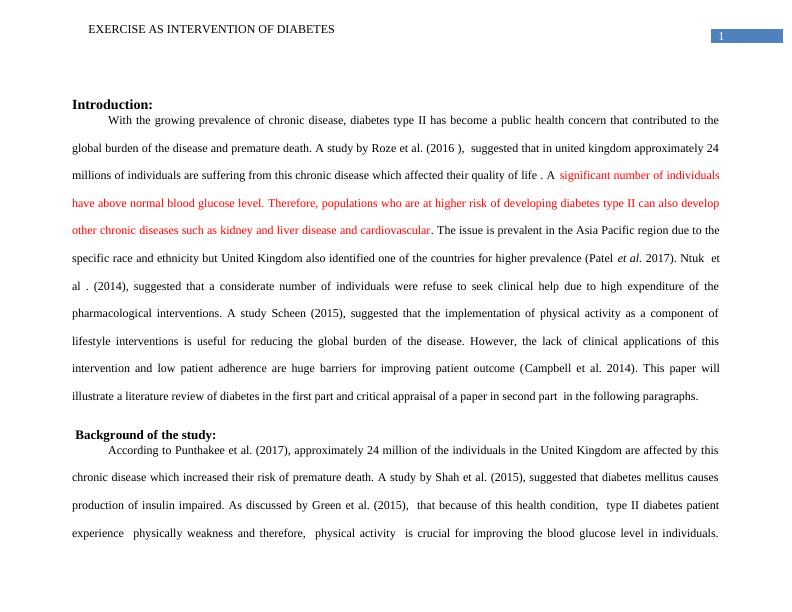
2
EXERCISE AS INTERVENTION OF DIABETES
Molecular biologist suggested that intensive physical activity is effective in enhancing the metabolism such as mitochondrial
biogenesis and beta-oxidation and molecular biogenesis. Li et al. (2017), argued that physical exercise proved to reduce 58% risk of
developing diabetes mellitus in pre-diabetic individuals and improved the quality of life in the patient with diabetes mellitus. Low et
al. (2014) suggested that only 40 % of the population engage in exercise as lifestyle interventions and 28.4% of them are able to
achieve a positive outcome. Accumulated evidence suggested that poor knowledge of individuals about lifestyle modification through
exercise and rare clinical practice of it are identified as a huge barrier for the management of the disease (Guest et al., 2015).
Therefore, literature reviews need to conduct for reducing the gap.
Research question:
In the United Kingdom can exercise therapy as non-pharmacological interventions be effective in the management of diabetes in a
population of 18 to 60 years old?
The rationale behind this question is that diabetes is public health concern that not only affected health but also affected the
psychological wellbeing. Therefore, the purpose of the research question is to identify whether exercise is effective for the
management of diabetes.
Strategy:
For constructing research question, the SPICE model was beneficial for identifying the type of search concept in the (appendix
A), it help in obtaining qualitative research articles. To find the research question, a specific research tool SPICE model which
evaluated the specific outcome and thus formulated research question was used for this literature review.
EXERCISE AS INTERVENTION OF DIABETES
Molecular biologist suggested that intensive physical activity is effective in enhancing the metabolism such as mitochondrial
biogenesis and beta-oxidation and molecular biogenesis. Li et al. (2017), argued that physical exercise proved to reduce 58% risk of
developing diabetes mellitus in pre-diabetic individuals and improved the quality of life in the patient with diabetes mellitus. Low et
al. (2014) suggested that only 40 % of the population engage in exercise as lifestyle interventions and 28.4% of them are able to
achieve a positive outcome. Accumulated evidence suggested that poor knowledge of individuals about lifestyle modification through
exercise and rare clinical practice of it are identified as a huge barrier for the management of the disease (Guest et al., 2015).
Therefore, literature reviews need to conduct for reducing the gap.
Research question:
In the United Kingdom can exercise therapy as non-pharmacological interventions be effective in the management of diabetes in a
population of 18 to 60 years old?
The rationale behind this question is that diabetes is public health concern that not only affected health but also affected the
psychological wellbeing. Therefore, the purpose of the research question is to identify whether exercise is effective for the
management of diabetes.
Strategy:
For constructing research question, the SPICE model was beneficial for identifying the type of search concept in the (appendix
A), it help in obtaining qualitative research articles. To find the research question, a specific research tool SPICE model which
evaluated the specific outcome and thus formulated research question was used for this literature review.
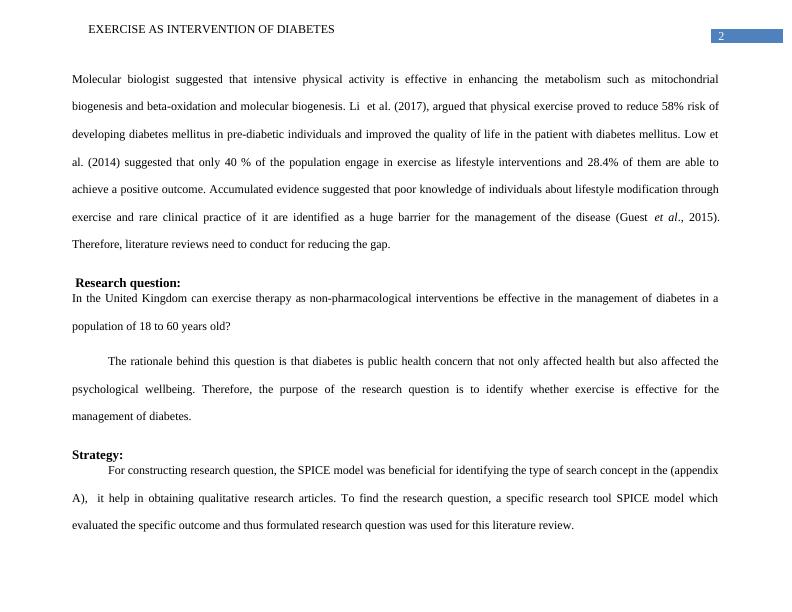
3
EXERCISE AS INTERVENTION OF DIABETES
Aim and objectives:
The purpose of the literature review is to evaluate the effectiveness of exercise therapy as non-pharmacological interventions in the
management of diabetes in a population of 18 to 60 years old through collecting evidence.
Objective:
• To explore the effectiveness of to exercise therapy in population between 18 to 60 years.
• To explore the reason behind lack of adherence
• To recommend strategies to adhere to the non-pharmacological interventions.
Design and Methodology
Because of the type the research question most appropriate nature of the study is the qualitative methodology as it provided a
relevant and possible result which further assists researchers in gaining details of the effectiveness of exercise therapy for management
of diabetes mellitus (Berger et al. 2015). The research was conducted using library where various articles were searched in order to
assess the effectiveness of physical activity for diabetic patient and adherence of it in the study. It is important to gather all of the
important information and critically analyses those articles in the realistic time frame for addressing the research question.
EXERCISE AS INTERVENTION OF DIABETES
Aim and objectives:
The purpose of the literature review is to evaluate the effectiveness of exercise therapy as non-pharmacological interventions in the
management of diabetes in a population of 18 to 60 years old through collecting evidence.
Objective:
• To explore the effectiveness of to exercise therapy in population between 18 to 60 years.
• To explore the reason behind lack of adherence
• To recommend strategies to adhere to the non-pharmacological interventions.
Design and Methodology
Because of the type the research question most appropriate nature of the study is the qualitative methodology as it provided a
relevant and possible result which further assists researchers in gaining details of the effectiveness of exercise therapy for management
of diabetes mellitus (Berger et al. 2015). The research was conducted using library where various articles were searched in order to
assess the effectiveness of physical activity for diabetic patient and adherence of it in the study. It is important to gather all of the
important information and critically analyses those articles in the realistic time frame for addressing the research question.
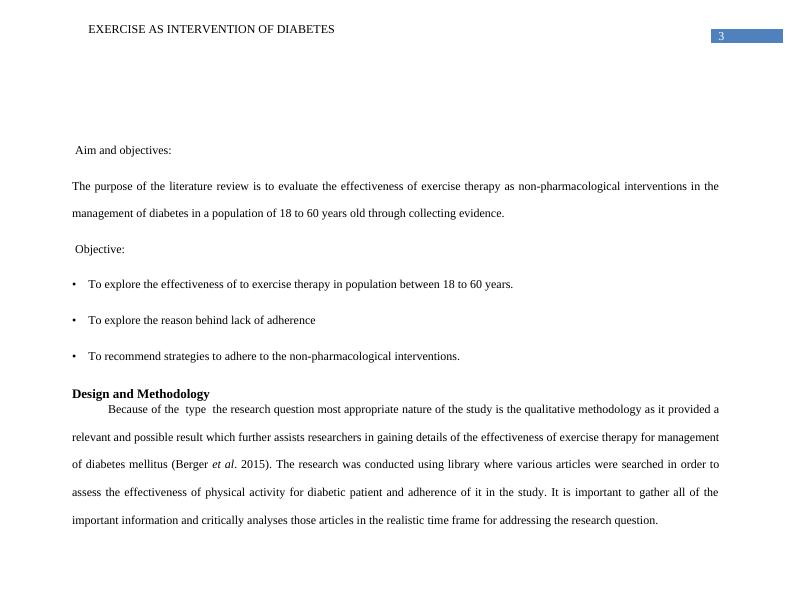
4
EXERCISE AS INTERVENTION OF DIABETES
Search for article and data extracting:
:
Once the research question had been formulated using specific research tool, it was possible to gather information and analyze articles
which were obtained after filtering range of evidence (Lewis 2015). There are specific inclusions and exclusion criteria for the articles
which was an roadmap for evaluation of the effect of exercise that further helped in obtaining the relevant article for research. The
research term that was used for the study including “type II diabetes mellitus”,” lifestyle intervention” “exercise’, “exercise-induced
metabolic changes”, “glucose metabolism”. To access articles, electronic databases were used such as CINAHL, Social Science
Citation index, Medline, in order to identify the accurate result of research question which would improve patient outcome.
The inclusion and exclusion criteria for the literature review are the following:
The inclusion and exclusion criteria for the literature review are following:
Inclusion criteria Exclusion criteria
All relevant journals included
were published within last 5
All relevant journal than 5
years were excluded
All non reviewed articles were
EXERCISE AS INTERVENTION OF DIABETES
Search for article and data extracting:
:
Once the research question had been formulated using specific research tool, it was possible to gather information and analyze articles
which were obtained after filtering range of evidence (Lewis 2015). There are specific inclusions and exclusion criteria for the articles
which was an roadmap for evaluation of the effect of exercise that further helped in obtaining the relevant article for research. The
research term that was used for the study including “type II diabetes mellitus”,” lifestyle intervention” “exercise’, “exercise-induced
metabolic changes”, “glucose metabolism”. To access articles, electronic databases were used such as CINAHL, Social Science
Citation index, Medline, in order to identify the accurate result of research question which would improve patient outcome.
The inclusion and exclusion criteria for the literature review are the following:
The inclusion and exclusion criteria for the literature review are following:
Inclusion criteria Exclusion criteria
All relevant journals included
were published within last 5
All relevant journal than 5
years were excluded
All non reviewed articles were
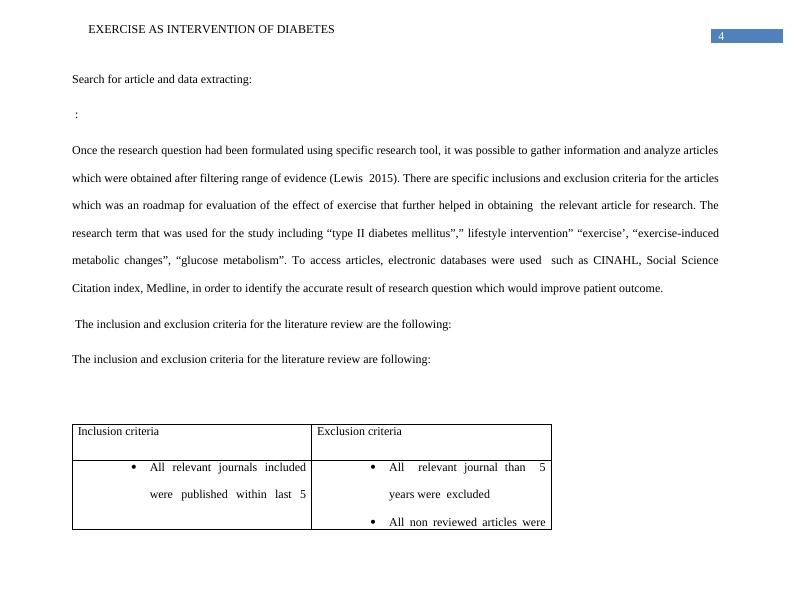
5
EXERCISE AS INTERVENTION OF DIABETES
years
All relevant paper that were
included in the study were peer
review journal
All relevant articles that were
included in the study were
published in English language.
All relevant paper that were
included in the study worked on
human subject.
All relevant paper which
discussed about the theories,
specific concepts was included.
all relevant paper that fit into
the check list of CASP tool
were included in the study
All relevant paper that
excluded
All articles published in other
than English article were
excluded.
All articles that published the
data work on other than human
subject will be eliminated.
All paper which discussed
other then theories, specific
concepts were excluded
all relevant paper that does not
fit into the check list of CASP
tool were included in the study
. All relevant paper that was
undertaken studies other than
EXERCISE AS INTERVENTION OF DIABETES
years
All relevant paper that were
included in the study were peer
review journal
All relevant articles that were
included in the study were
published in English language.
All relevant paper that were
included in the study worked on
human subject.
All relevant paper which
discussed about the theories,
specific concepts was included.
all relevant paper that fit into
the check list of CASP tool
were included in the study
All relevant paper that
excluded
All articles published in other
than English article were
excluded.
All articles that published the
data work on other than human
subject will be eliminated.
All paper which discussed
other then theories, specific
concepts were excluded
all relevant paper that does not
fit into the check list of CASP
tool were included in the study
. All relevant paper that was
undertaken studies other than
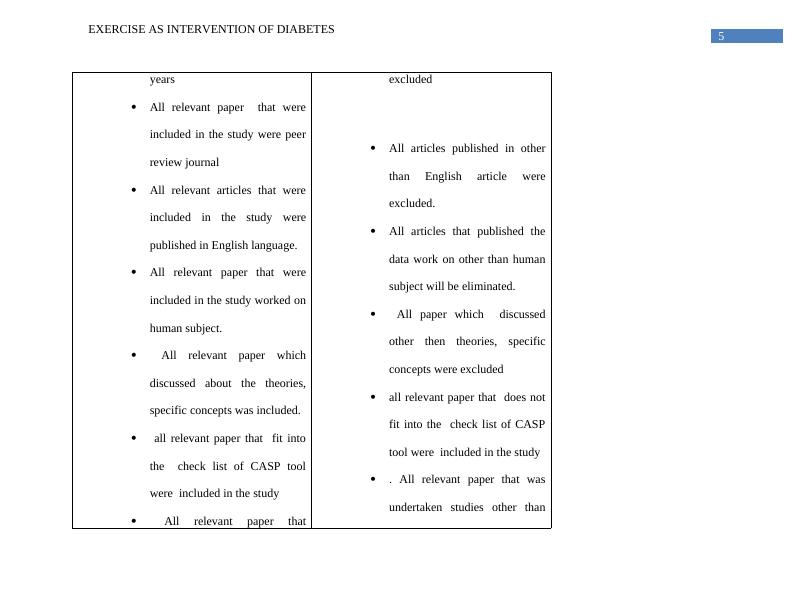
6
EXERCISE AS INTERVENTION OF DIABETES
undertaken primary studies
were included.
primary studies were excluded.
Once all the articles had been filtered, 5423 articles which were further filtered for eliminating duplicates. After elimination of all
irreverent articles, 8 articles were selected from 63 articles corresponding with the inclusion criteria. In order to gain theme with the
help of prisma flowchart, different range of the study was evaluated and ultimately 8 journals were selected for best comprehensive
study (Moher et al. 2015). After obtaining these eight articles, these articles assisted researchers to categorize as well as analyze
different themes of the research.
Results Synthesis and Quality Appraisal of 8:
In order to identify the strength and limitation of each article, it is crucial to analyze and appraise each article which relate to
the research question for addressing the current issue (Lockwood et al. 2014). All of the articles were analyzed by using different
parameters such as methodology. Articles were assessed for different theme generation such as the effect of exercise on diabetes, the
effect of exercise on weight reduction and effect of exercise on metabolism.
Using data extraction table found in appendix C, the researcher was able to assess what is important for the study. The aim of
this is to provide clarity regarding extracted paper without re-examining the original articles. The extracted articles were assessed in
EXERCISE AS INTERVENTION OF DIABETES
undertaken primary studies
were included.
primary studies were excluded.
Once all the articles had been filtered, 5423 articles which were further filtered for eliminating duplicates. After elimination of all
irreverent articles, 8 articles were selected from 63 articles corresponding with the inclusion criteria. In order to gain theme with the
help of prisma flowchart, different range of the study was evaluated and ultimately 8 journals were selected for best comprehensive
study (Moher et al. 2015). After obtaining these eight articles, these articles assisted researchers to categorize as well as analyze
different themes of the research.
Results Synthesis and Quality Appraisal of 8:
In order to identify the strength and limitation of each article, it is crucial to analyze and appraise each article which relate to
the research question for addressing the current issue (Lockwood et al. 2014). All of the articles were analyzed by using different
parameters such as methodology. Articles were assessed for different theme generation such as the effect of exercise on diabetes, the
effect of exercise on weight reduction and effect of exercise on metabolism.
Using data extraction table found in appendix C, the researcher was able to assess what is important for the study. The aim of
this is to provide clarity regarding extracted paper without re-examining the original articles. The extracted articles were assessed in

7
EXERCISE AS INTERVENTION OF DIABETES
order to identify it was fit for the purpose or not (Alvesson and Sköldberg 2017). Once all of the articles were methodically read
through for generating logical themes, the literature synthesis was done.
Miller et al. (2018) suggested that in order obtain accurate literature review, it is crucial to identify the studies which are
appropriate for the synthesis of the result. The articles were that was mostly randomized trail control and using meta-synthesis
approach, each articles were assessed thoroughly. Few cohort studies are also included for gaining appropriate result in order to
address the research question. Qualitative meta-synthesis is defined as a coherent and international approach of literature for analyzing
the data of qualitative studies (Herber et al. 2015). This process is useful in assisting researchers in identifying a research question and
select, appraise and summarize the combination of different qualitative studies for addressing the research question (Brundisini et al.
2015). Therefore, Meta-synthesis is extremely crucial for the successful accomplishment of the study. However, the limitation of
these eight articles also identified after assessing these paper thoroughly. The limitations of these eight articles are that these articles
although researchers were tried to address the issue and use exercise as a lifestyle interventions for managing diabetes, These studies
failed to answer each part of the question. Moreover, the majority of the studies were conducted in the United Kingdom and thereby,
level of cultural homogeneity is a potential bias of these studies which might not be applicable for the patients who are living in other
countries.
These articles were filtered again using a specific tool for the diagnosis tool ( critical appraisal skill program ) produced by
Kitchenham (2007), which was intended to appraise specific papers by subjecting each paper in specific scales of questions such as
EXERCISE AS INTERVENTION OF DIABETES
order to identify it was fit for the purpose or not (Alvesson and Sköldberg 2017). Once all of the articles were methodically read
through for generating logical themes, the literature synthesis was done.
Miller et al. (2018) suggested that in order obtain accurate literature review, it is crucial to identify the studies which are
appropriate for the synthesis of the result. The articles were that was mostly randomized trail control and using meta-synthesis
approach, each articles were assessed thoroughly. Few cohort studies are also included for gaining appropriate result in order to
address the research question. Qualitative meta-synthesis is defined as a coherent and international approach of literature for analyzing
the data of qualitative studies (Herber et al. 2015). This process is useful in assisting researchers in identifying a research question and
select, appraise and summarize the combination of different qualitative studies for addressing the research question (Brundisini et al.
2015). Therefore, Meta-synthesis is extremely crucial for the successful accomplishment of the study. However, the limitation of
these eight articles also identified after assessing these paper thoroughly. The limitations of these eight articles are that these articles
although researchers were tried to address the issue and use exercise as a lifestyle interventions for managing diabetes, These studies
failed to answer each part of the question. Moreover, the majority of the studies were conducted in the United Kingdom and thereby,
level of cultural homogeneity is a potential bias of these studies which might not be applicable for the patients who are living in other
countries.
These articles were filtered again using a specific tool for the diagnosis tool ( critical appraisal skill program ) produced by
Kitchenham (2007), which was intended to appraise specific papers by subjecting each paper in specific scales of questions such as
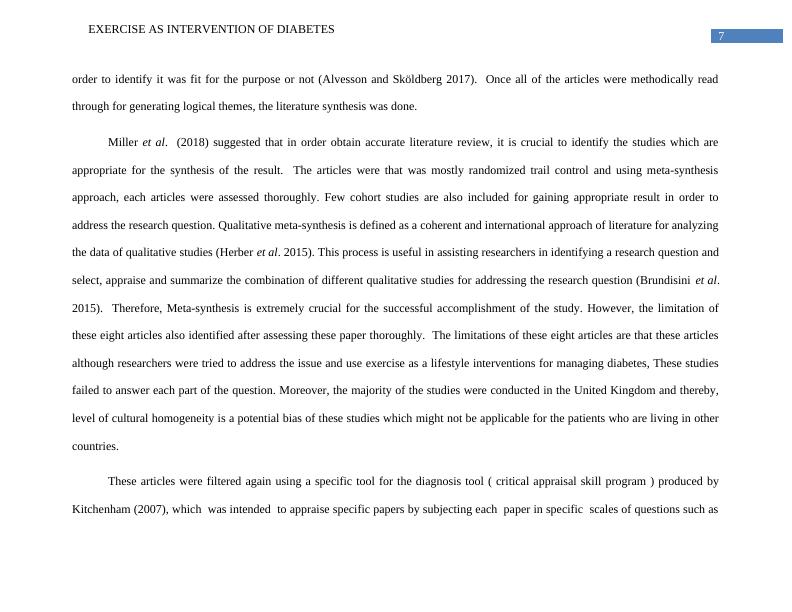
End of preview
Want to access all the pages? Upload your documents or become a member.
Related Documents
Effects of Interval Training of Exercise on Prognosis of Type II Diabetes Mellituslg...
|18
|4013
|62
EXERCISE AS INTERVENTION OF DIABETES Exercise as intervention oflg...
|22
|5995
|249
HLN707 Research Methods in Healthlg...
|10
|2556
|129
Diabetes Mellitus and Associated Pharmacological Treatmentlg...
|4
|558
|460
Annotated Bibliography on Non-Pharmacological Intervention for Type 2 Diabetes Mellituslg...
|12
|3513
|108
Management of Diabetes Mellituslg...
|11
|3138
|127
